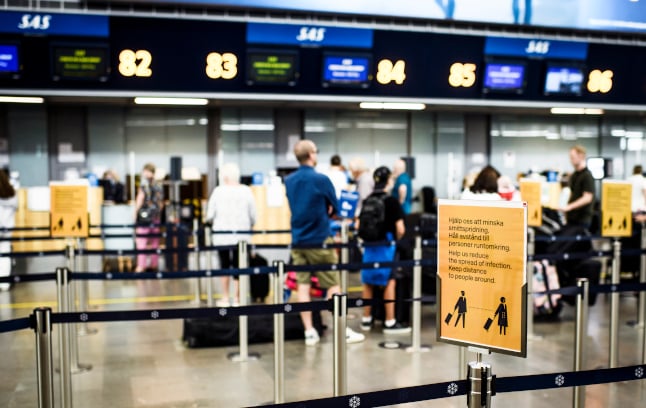The entry ban was previously set to expire on August 31st, but the government on Thursday extended it until October 31st.
The ban has been in place since March last year, and was introduced in line with EU recommendations at the time to curb the spread of coronavirus across the union. There are however several exemptions to the ban, including if you live in Sweden or the EU, if you’re travelling for certain purposes such as urgent family reasons and vital work, or if you’re travelling from certain low-infection countries which are decided at the EU level. There are also exemptions for athletes and esports players taking part in elite competitions.
People from EU countries, as well as the following non-EU/EEA countries, are exempt from the entry ban: Albania, Armenia, Australia, Azerbaijan, Bosnia and Herzegovina, Brunei, Hong Kong, Israel, Japan, Jordan, Canada, Kosovo, Libanon, Macao, Moldova, North Macedonia, New Zealand, Qatar, Saudi Arabia, Serbia, Singapore, South Korea, Taiwan, Ukraine or the United States of America.
You must also show a negative Covid-19 test, unless you fall into a category that is exempt from this too (this includes Swedish citizens and residents, and you can find a full list on the Police Authority’s website), if you are travelling from a non-EU country. If you are travelling from an EU country, you can alternatively show proof that you have been vaccinated against Covid-19, or recovered from it in the past six months.
If you are travelling from one of the Nordic countries – Denmark, Norway, Finland or Iceland – you can enter Sweden freely for any reason and you don’t have to present a negative Covid-19 test.
In addition to the entry ban, Sweden also has a set of test-and-isolate recommendations in place for people travelling to Sweden. You can read more about those on the Public Health Agency’s website.
Sweden on Thursday also extended its advisory against non-essential travel from Sweden until October 15th.
All EU countries as well as the UK, EEA and Schengen are exempt from the advisory, as are the following countries: Albania, Armenia, Australia, Azerbaijan, Bosnia & Herzegovina, Brunei, Canada, Hong Kong, Israel, Jordan, Kosovo, Lebanon, Macao, Moldova, Montenegro, New Zealand, North Macedonia, Qatar, Saudi Arabia, Serbia, Singapore, South Korea, Taiwan and the USA.
Although the advice against non-essential travel abroad is not legally binding, it is intended to dissuade people from non-essential travel and can have implications on the validity of travel insurance if you travel against official advice. Even if travelling to countries on the exemption list, the Foreign Ministry advises making a personal risk assessment, reading up on local travel restrictions and Covid-19 rules, and plan for the trip home well in advance.



 Please whitelist us to continue reading.
Please whitelist us to continue reading.
Am I understanding correctly , can I travel from Stansted via Copenhagen( without staying overnight in Copenhagen )
and then get bus or train to Gothenburg and be allowed in so I can visit my young granddaughters and my daughter who really needs my support since she split with Swedish partner at the start of Covid March 2020 .
I have flight booked Sept 9 th to Goteborg , its my 7th attempt and this time it has not been cancelled , so I am going to loose the flight money as I assume I will not be allowed over the border .
I am double vaccined since March but in England so not recognised in Sweden . Any advice gratefully received .
I am desperate to go and support my daughter who has no other family there.
Michelle